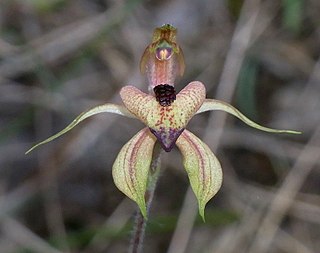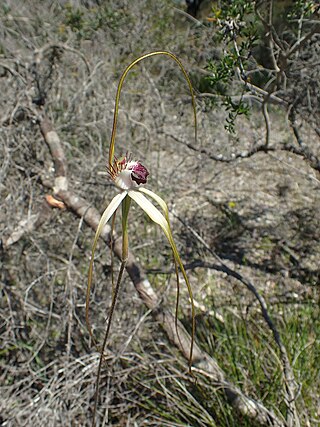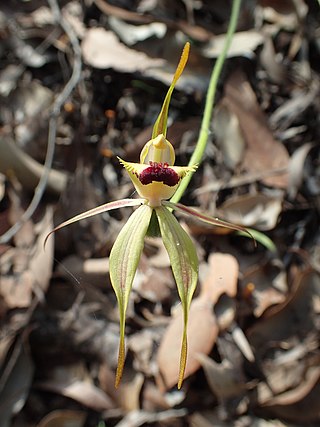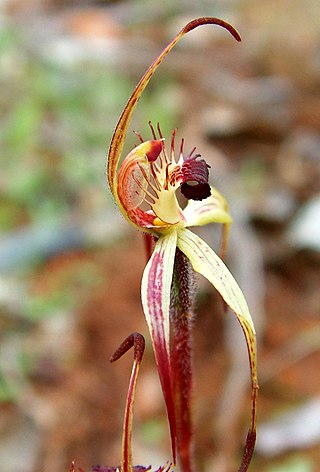
Caladenia capillata, commonly known as white daddy long legs or wispy spider orchid, is a plant in the orchid family Orchidaceae and is endemic to Victoria and South Australia. It is a ground orchid with a single hairy leaf and up to three cream-coloured to yellowish flowers with long, thread-like petals and sepals and a very small labellum.

Caladenia cardiochila, commonly known as thick-lipped spider-orchid, fleshy-lipped caladenia and heartlip spider-orchid, is a plant in the orchid family Orchidaceae and is endemic to Victoria and South Australia. It is a ground orchid with a single hairy leaf and one or two yellowish-green, red-striped flowers on a thin, wiry stem.
Caladenia colorata, commonly known as coloured spider-orchid, small western spider-orchid and painted spider-orchid is a plant in the orchid family Orchidaceae and is endemic to South Australia and possibly Victoria. It is a ground orchid with a single hairy leaf, and usually a single creamy-green flower with blood-red or purple-brown markings and with dark tips on the petals and sepals.

Caladenia cruscula, commonly known as the reclining spider orchid is a species of orchid endemic to a small area in the south-west of Western Australia. It has a single hairy leaf and a single cream-coloured flower with a long red fringe on the sides of its labellum.

Caladenia excelsa, commonly known as the giant spider orchid, is a species of orchid endemic to a small area in the south-west of Western Australia. It is a rare species with a single, hairy leaf and up to three cream-coloured to greenish-cream flowers with long, drooping sepals and petals. It is one of the tallest spider orchids in Western Australia and, with Caladenia splendens, has the largest flowers of any Western Australian orchid.

Caladenia fragrantissima, commonly known as the scented spider orchid, is a plant in the orchid family Orchidaceae and is endemic to Victoria and South Australia. It is a ground orchid with a single hairy leaf and up to three creamy-white to yellowish-green flowers. It is possible that it is conspecific with Caladenia orientalis.
Caladenia fuscolutescens, commonly known as the ochre spider orchid, is a species of orchid endemic to the south-west of Western Australia. It has a single, hairy leaf and one or two brownish-yellow flowers with a pale yellow, red-striped labellum. It is most common in spring after bushfires in the previous summer.

Caladenia georgei, commonly known as the tuart spider orchid, is a species of orchid endemic to the south-west of Western Australia. It has a single, hairy leaf and up to three whitish to yellowish-green flowers flushed with red and which have a white labellum with a red tip.
Caladenia graniticola, commonly known as the Pingaring spider orchid, is a species of orchid endemic to the south-west of Western Australia. It has a single, hairy leaf and one or two yellowish-green, red and white flowers which have a greenish-yellow and white labellum with a red tip. It was originally described as Caladenia hoffmanii subsp. graniticola but has a slightly different labellum and column.

Caladenia granitora, commonly known as the granite spider orchid, is a species of orchid endemic to the south-west of Western Australia. It has a single, hairy leaf and one or two yellowish-cream, white and red flowers which have a white labellum with a red tip.

Caladenia horistes, commonly known as the cream spider orchid is a species of orchid endemic to the south-west of Western Australia. It has a single, hairy leaf and one or two, creamy-yellow flowers which have a red-striped labellum and long, dark, thread-like tips on the sepals and petals.
Caladenia lodgeana, commonly known as Lodge's spider orchid, is a species of orchid endemic to a restricted area of the south-west of Western Australia. It has a single, hairy leaf and up to three cream, red and pink flowers and a labellum which lacks the red tip common to many other similar caladenias.
Caladenia meridionalis, commonly known as the south coast spider orchid, is a species of orchid endemic to the south-west of Western Australia. It is an early-flowering orchid with a single erect, hairy leaf and one or two white flowers with long, drooping lateral sepals and petals.

Caladenia paradoxa, commonly known as the ironcaps spider orchid, is a species of orchid endemic to the south-west of Western Australia. It has a single erect, hairy leaf and up to three small creamy-white flowers. It was previously thought to be the same species as the eastern Australian Caladenia flaccida but is now recognised as distinct.
Caladenia patersonii is a plant in the orchid family Orchidaceae and is native to Victoria and Tasmania. It is a ground orchid with a single hairy leaf and one or two creamy-white, yellowish or pink flowers.
Caladenia postea, commonly known as the dark-tipped spider orchid, is a species of orchid endemic to the south-west of Western Australia. It has a single erect, hairy leaf and up to three small, pale creamy-white flowers. It has a relatively late flowering period compared to similar spider orchids.

Caladenia rhomboidiformis, commonly known as the diamond spider orchid, is a species of orchid endemic to the south-west of Western Australia. It has a single erect, hairy leaf and one or two green, yellow and red flowers. Until 1971 It was known as a variety of the green comb spider orchid Caladenia dilatata then, until 1989 as a variety of the clubbed spider orchid, Caladenia longiclavata.

Caladenia villosissima, commonly known as the hairy spider orchid, is a plant in the orchid family Orchidaceae and is endemic to Victoria. It is a ground orchid with a single densely hairy leaf and a single pale green flower with red stripes along the sepals and petals. It is a poorly known species and there is insufficient information about its distribution and abundance to determine whether or not it is endangered.

Caladenia williamsiae, commonly known as Judy's spider orchid, or Williams' spider orchid is a species of orchid endemic to the south-west of Western Australia. It is a rare species with a single relatively large, erect, hairy leaf and one or two delicate, greenish-yellow and red flowers. It is only known from a single population near Brookton.

Caladenia xantha, commonly known as the primrose spider orchid, is a species of orchid endemic to the south-west of Western Australia. It has a single erect, hairy leaf and up to three yellow flowers with a cream-coloured, brown-striped labellum.














